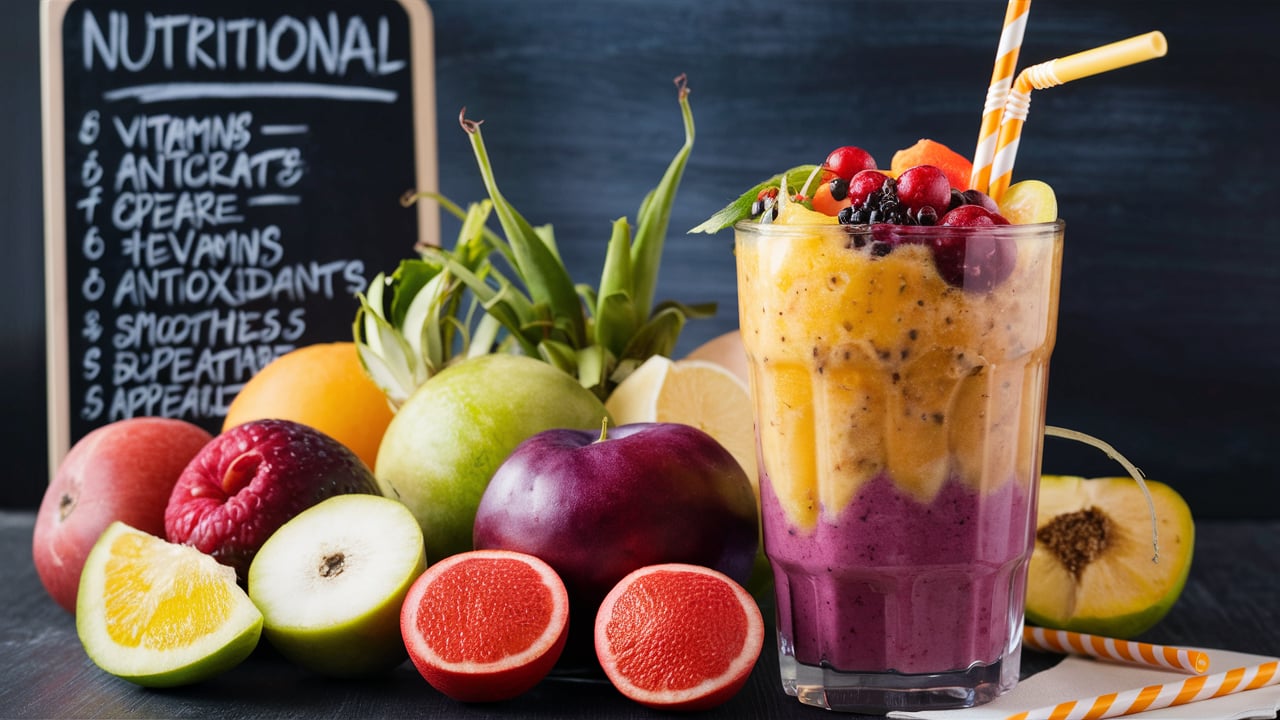Part 1: Understanding Pulp Smoothies
What Are Pulp Smoothies?
Pulp smoothies have emerged as a popular alternative to traditional juices, known for their ability to retain the fiber from whole fruits and vegetables. Unlike juices, which often remove the fibrous content, pulp smoothies maintain the pulp, resulting in a thicker and more satisfying drink. This isn’t just a matter of texture preference; the fiber in these smoothies plays a crucial role in digestion and gut health, and it helps you feel fuller for longer periods.
Fiber in pulp smoothies can also help regulate blood sugar levels. This is especially beneficial for those who experience energy dips or sugar crashes after consuming high-sugar snacks or beverages. By retaining the fiber, pulp smoothies slow the absorption of sugar into the bloodstream, leading to more stable energy levels. This makes them an attractive option for those looking to avoid the highs and lows of sugary drinks.
Moreover, pulp smoothies preserve the vitamins and antioxidants found in fruits and vegetables, making them a great way to pack more nutrients into your diet without missing out on any of the benefits of whole foods. However, the overall health impact of a pulp smoothie depends significantly on the ingredients you choose to include.
Nutritional Benefits of Pulp Smoothies
The nutritional content of pulp smoothies is heavily influenced by the ingredients you select. Blending whole fruits and vegetables allows you to retain essential vitamins, minerals, and antioxidants, which can significantly boost your health. For instance, adding leafy greens like spinach or kale can provide vitamins A, C, and K, along with essential minerals like iron and calcium.
The inclusion of fiber is a key differentiator between smoothies and traditional juices. Fiber not only supports a healthy digestive system but also plays a critical role in blood sugar regulation and weight management. A fiber-rich smoothie can help you feel full longer, preventing overeating and reducing the need for snacks between meals.
Beyond fiber, pulp smoothies are often rich in antioxidants, depending on the ingredients. Antioxidants are vital for combating inflammation and protecting the body from free radicals, which contribute to chronic conditions like heart disease, cancer, and diabetes. Selecting antioxidant-rich ingredients can make your smoothie a powerful tool in supporting long-term health.
Common Ingredients in Pulp Smoothies
One of the biggest advantages of pulp smoothies is their versatility. You can tailor them to meet your specific nutritional needs, taste preferences, and health goals. Here are some common ingredients found in pulp smoothies and their associated health benefits:
- Bananas: A popular base for smoothies, bananas provide a creamy texture and are a great source of potassium, which is essential for heart health and muscle function.
- Berries: Rich in antioxidants, berries such as blueberries, strawberries, and raspberries help reduce inflammation and support brain health. They are also low in calories and high in fiber.
- Spinach and Kale: These leafy greens are nutrient-dense and low in calories, offering vitamins A, C, and K, as well as iron and calcium.
- Avocado: Avocados add healthy fats to your smoothie, essential for brain health, and help you feel full longer. They are also rich in potassium, fiber, and vitamins C, E, and K.
- Chia Seeds: These tiny seeds are packed with fiber, omega-3 fatty acids, and protein, making them a powerful addition to any smoothie.
Combining these ingredients in various ways allows you to create nutrient-dense smoothies that support a wide range of health goals, from weight management to heart health and improved brain function.
Part 2: Health Considerations with Pulp Smoothies
How Many Calories Are in a Pulp Smoothie?
The calorie content of a pulp smoothie can vary widely depending on the ingredients you use. A basic smoothie made with just fruits and vegetables typically contains between 150 and 250 calories. However, adding calorie-dense ingredients like nut butter, full-fat yogurt, or protein powder can raise the calorie count to 400-600 calories or more.
To keep your smoothie lower in calories, focus on using high-nutrient, low-calorie ingredients like leafy greens and berries. Apps like MyFitnessPal can help you calculate the nutritional breakdown of your smoothies and ensure they fit within your desired calorie range, especially if you’re aiming to manage your weight or maintain a calorie deficit.
Pulp Smoothies vs. Juices: Which Is Healthier?
Pulp smoothies are often considered healthier than juices because they retain the fiber from whole fruits and vegetables. Juices, on the other hand, can be high in sugar and low in fiber due to the juicing process that removes the fibrous parts. Without fiber, juices can cause rapid spikes in blood sugar, followed by crashes in energy.
While both smoothies and juices have their benefits, smoothies tend to provide more sustained energy and contribute to better blood sugar regulation. However, it’s still important to watch your portion sizes and avoid overloading your smoothies with fruit, which can lead to high sugar consumption. Balancing your smoothies with vegetables and adding a source of protein can make them more balanced and satisfying.
Are There Any Downsides to Pulp Smoothies?
While pulp smoothies offer numerous health benefits, they’re not without potential downsides. Here are some things to consider if you’re drinking them regularly:
- Calorie Content: Depending on the ingredients, pulp smoothies can be calorie-dense. Be mindful of portion sizes, particularly with high-calorie add-ins like nut butter and avocado.
- Sugar Content: Even natural sugars from fruits can impact your health, especially if consumed in large amounts. Balancing your smoothie with vegetables can help mitigate this.
- Variety: Relying too heavily on smoothies can limit the variety in your diet. It’s important to include whole foods and a range of nutrients to ensure you’re meeting your dietary needs.
Smoothies should complement your diet, not replace whole meals regularly. Balance them with other nutrient-dense foods to maintain a well-rounded diet.
Tips for Making Healthier Pulp Smoothies
To maximize the health benefits of your pulp smoothies, consider these tips:
- Prioritize Vegetables: Use vegetables as the base of your smoothies to reduce sugar content and increase nutrient density.
- Control Portions: Measure out calorie-dense ingredients to avoid overloading your smoothie with unnecessary calories.
- Limit Sweeteners: Skip added sugars and rely on the natural sweetness of fruits like berries or bananas.
- Add Protein and Healthy Fats: Incorporate protein sources like Greek yogurt or protein powder, and healthy fats like chia seeds or avocado, to make your smoothie more balanced.
- Blend and Enjoy Slowly: Sip your smoothie slowly to give your body time to register fullness and support better digestion.
Part 3: The Role of Pulp Smoothies in a Balanced Diet
Can Pulp Smoothies Replace Meals?
While pulp smoothies can be a convenient and nutritious option, they shouldn’t replace entire meals regularly. A well-rounded diet includes a variety of whole foods like fruits, vegetables, grains, and proteins. Smoothies can complement this diet, especially when paired with other nutrient-dense foods throughout the day. For instance, if you have a smoothie for breakfast, consider adding a small portion of whole grains or lean protein to ensure you’re getting a balanced intake of nutrients.
Testimonials: What People Are Saying About Pulp Smoothies
Many people have incorporated pulp smoothies into their daily routines with positive results:
- Sarah K.: “Pulp smoothies have become a daily ritual for me. The fiber keeps me full, and I love packing in so many nutrients. They’re great for busy days when I need something quick.”
- Mike L.: “I’ve noticed a big improvement in my digestion since I started drinking pulp smoothies. The fiber makes a huge difference, and I feel more energized throughout the day.”
- Jessica P.: “As someone who struggles with balancing my blood sugar, pulp juices have been a game-changer. By focusing on vegetables and adding protein, I can enjoy a smoothie without worrying about sugar spikes.”
These testimonials reflect the versatility and health benefits of pulp smoothies, making them a popular choice for health-conscious individuals.
Balancing Smoothies with Other Nutrient-Dense Foods
Smoothies can be part of a balanced diet, but it’s important to complement them with a variety of whole foods. Eating a diverse range of fruits, vegetables, grains, and proteins ensures you’re getting a wide spectrum of vitamins and minerals. Pair your smoothies with meals that provide different nutrients, such as salads with lean protein or whole-grain options.
Part 4: Conclusion and Final Thoughts
Are Pulp Smoothies Actually Healthy?
Pulp juices can be a healthy addition to your diet when prepared with mindful ingredient choices. They offer a convenient way to consume fiber, vitamins, and antioxidants. However, it’s essential to monitor portion sizes, sugar content, and overall balance. By being thoughtful about the ingredients and keeping an eye on calorie and sugar levels, you can enjoy the benefits of pulp juices while supporting your health and wellness goals.
With the right approach, pulp juices can play a valuable role in helping you meet your nutritional needs, whether you’re looking to boost your intake of fruits and vegetables, increase fiber consumption, or enjoy a satisfying snack.
FAQs About Pulp Smoothies
Can I drink pulp smoothies every day? Yes, you can enjoy pulp juices daily, but it’s important to balance them with a variety of other foods. Incorporate whole grains, lean proteins, and healthy fats into your diet to ensure you’re getting a wide range of nutrients.
How many calories are in a typical pulp smoothie? The calorie content of a pulp smoothie can range from 150-250 calories for a basic smoothie to 400-600 calories or more for one with added proteins, fats, or sweeteners. To get a precise idea of the calorie content, consider using a nutrition tracking app.
Are pulp smoothies good for weight loss? Pulp smoothies can aid in weight loss, especially when they’re rich in fiber and protein and made with low-calorie ingredients. However, be mindful of portion sizes and avoid calorie-dense add-ins if your goal is weight loss.
Can I freeze pulp smoothies for later? Yes, you can freeze pulp juices for later consumption. Freeze them in individual portions to make it easy to grab a quick, healthy meal on busy days. Thaw them in the fridge overnight or blend them with a little extra liquid when you’re ready to drink.
Are pulp smoothies suitable for people with diabetes? Pulp smoothies can be a healthy option for people with diabetes if they contain low-sugar ingredients and are balanced with vegetables and protein. Always consult with a healthcare provider if you have specific dietary concerns related to diabetes.
This revision ensures improved readability while maintaining a strong focus on the health benefits and considerations of pulp smoothies. It also incorporates testimonials, practical tips, and frequently asked questions to make the content more engaging and informative.

